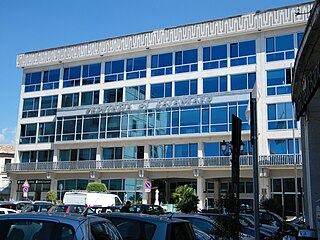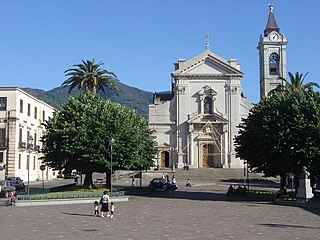
Catanzaro, also known as the "City of the two Seas", is an Italian city of 86,183 inhabitants (2020), the capital of the Calabria region and of its province and the second most populated comune of the region, behind Reggio Calabria.

The province of Catanzaro is a province of the Calabria region of Italy. The city Catanzaro is both capital of the province and capital of the region of Calabria. The province contains 80 comuni. Its provincial president is Sergio Abramo.

The province of Reggio Calabria was a province in the Calabria region of Italy. It was the southernmost province in mainland Italy and is separated from the island of Sicily by the Strait of Messina. The capital was the city of Reggio.

The Staplehurst rail crash was a derailment at Staplehurst, Kent, on 9 June 1865 at 3:13 pm. The South Eastern Railway Folkestone to London boat train derailed while crossing a viaduct where a length of track had been removed during engineering works, killing ten passengers and injuring forty. In the Board of Trade report it was found that a man had been placed with a red flag 554 yards (507 m) away but the regulations required him to be 1,000 yards (910 m) away and the train had insufficient time to stop.

Soveria Mannelli is a town and comune in the province of Catanzaro, in the Calabria region of southern Italy.

The Shrewsbury rail accident occurred on 15 October 1907. An overnight sleeping-car and mail train from Manchester to the West of England derailed on the sharply curved approach to Shrewsbury station, killing 18 people and injuring 33. The accident was concluded to be due to excessive speed on a dangerous curve.

The Diocese of Oppido Mamertina-Palmi is a Latin diocese of the Catholic Church in southern Italy, existing under that name since 1979. Historically it was the Diocese of Oppido Marmertina (Oppidensis). It is a suffragan see of the Archdiocese of Reggio Calabria.

Catanzaro Lido railway station is one of the railway stations serving the city and comune of Catanzaro, capital of the Calabria region, southern Italy. Opened in 1875, it forms part of the Jonica railway, and is also a terminus of a secondary line, the Lamezia Terme–Catanzaro Lido railway.

Catanzaro, commonly known as Catanzaro Sala for the position in Sala quarter and due to the name of the adjacent FC station, is a railway station of the Italian city of Catanzaro, in Calabria region.
The Crevalcore train crash was a major railway accident which occurred on 7 January 2005 on the Verona–Bologna railway, Italy, killing 17. It was one of the worst crashes in the recent history of the state railway company Ferrovie dello Stato. In the collision, a cargo and a passenger train collided in dense fog after the passenger train's driver passed two red signals, possibly as a result of an unwarranted assumption by the driver that the line was clear, despite the warning signals.
The Curinga train disaster, also known as the Lamezia Terme train disaster, was a railway accident occurred on 21 November 1980 between Curinga and Eccellente stations, in the Catanzaro province, Italy.
Agazio di Somma was a Roman Catholic prelate and Baroque writer who served as Bishop of Catanzaro (1664–1671) and Bishop of Cariati e Cerenzia (1659–1664).

Camillo Mercalli was an Italian general during World War II.
Michele Guerrisi was an Italian sculptor, painter and writer.
A series of mainshocks struck Calabria on March 27–28 and June 9, 1638. The first three earthquakes had moment magnitudes estimated to be 6.6–7.1. On June 9, another mainshock estimated at Mw 6.7 struck the same region, causing further damage and casualties. The four earthquakes resulted in as many as 30,000 fatalities.












